Introduction: This promotional souvenir book was issued by the Great Northern Telegraph Company on their centenary in 1969 and illustrated the company's origins and history.
Bill Glover's article on Great Northern gives further details of the company's early operations, and includes information on their cableships and the cables laid. Thanks also to Bill Glover for preparing the scans and text for this page.
|
| --Bill Burns |
THE GREAT NORTHERN TELEGRAPH COMPANY
An Outline of the Company's History 1869-1969
|
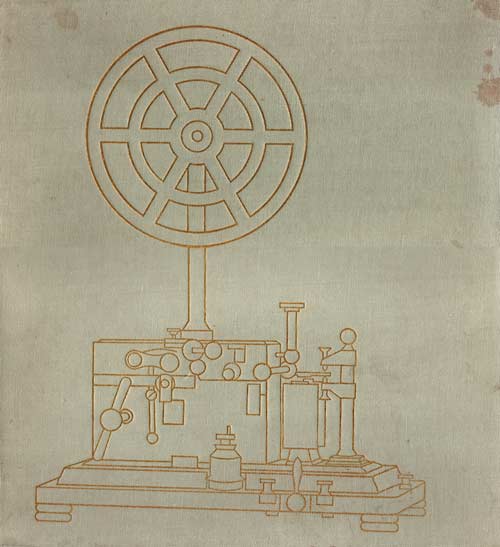
Front cover |
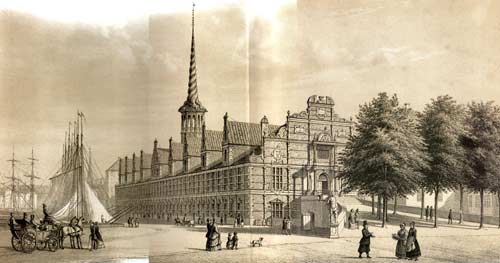
Illustration on the front double end‑paper:
The Copenhagen Stock
Exchange (completed 1640)
where The Great Northern Telegraph
Company
was founded and had its Head Office until 1878 |
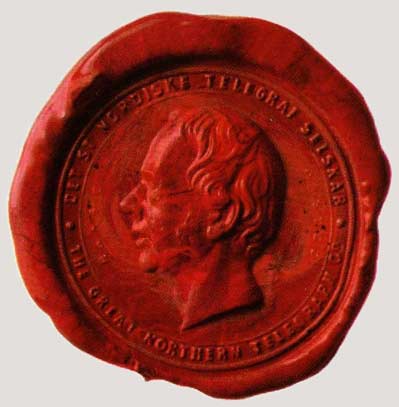
Detail of illustration on the half‑title page:
The Company's Seal with a portrait of H.C. Oersted,
the discoverer of electro‑magnetism. |
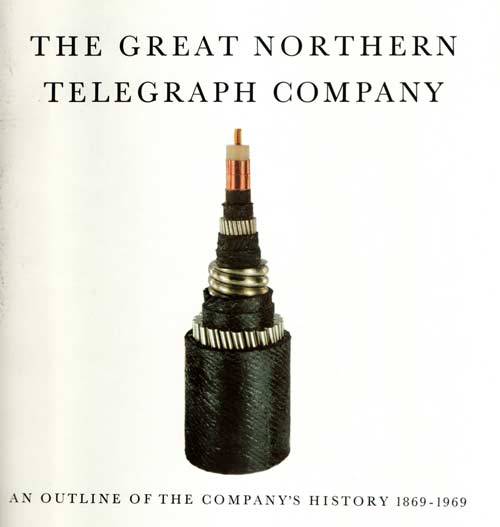
Illustration on the title‑page:
Triple‑armoured submarine coaxial cable of a special
type
developed at the request of the Company for
laying in
certain waters where cables are particularly
exposed to damage by icebergs and trawlers. |

Aerial photograph of Kongens Nytorv
with the Company's present Head Office. |
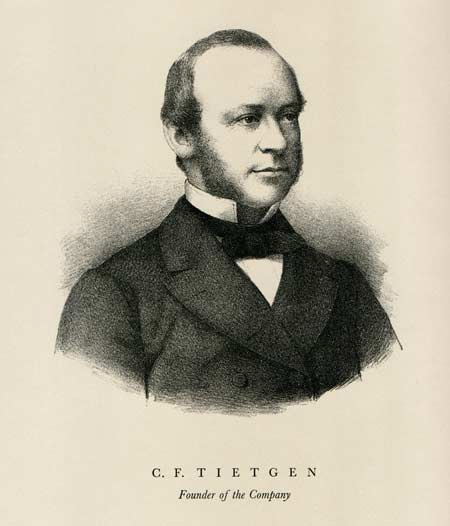
C.F. Tietgen
Founder of the Company |
On the 1st of June 1969, 100 years will have passed since The Great Northern Telegraph Company was founded. The Northern began its activities when international telegraphy by means of submarine cables was in its infancy, and the Company has taken part in the development of the service from the original submarine cables, which usually contained only a single telegraph core, to the modern cables which carry a great number of telegraph and telephone channels simultaneously; and from the time when the telegram was the sole method of exchanging messages between countries by electrical means, to the present day when a number of diverse international telecommunication services is available to the public
In retrospect, against the background of the external factors that have influenced the development and prosperity of the Northern, it seems natural to view the history of the Company in three periods, broadly speaking divided by the two World Wars.
The Foundation of the Company.
The Period before the First World War.
THE FIRST STEPS to establish submarine cable connections between the Scandinavian countries and other parts of the world had already been taken some years before the Northern was founded. In April 1868, the DANISH‑NORWEGIAN‑ENGLISH TELEGRAPH COMPANY was formed with C. F. Tietgen as Chairman. This company, which had obtained a concession to land and operate submarine cables between Denmark and England and between Denmark and Norway, took over a Danish‑Norwegian cable laid in 1867 between Hirtshals and Arendal, and in September 1868 opened a direct Anglo-Danish cable between Soendervig and Newbiggin, near Newcastle.
Later that same year, the DANISH‑RUSSIAN TELEGRAPH COMPANY was formed. This company had the same Board of Directors as the Danish‑Norwegian‑English Company and had obtained a concession to establish a Danish‑Russian cable system in addition to an assurance of a concession to lay a Swedish‑Finnish cable.
Simultaneously with this latter development a Norwegian company, the NORWEGIAN-BRITISH SUBMARINE TELEGRAPH COMPANY, planned to lay a direct telegraph cable between Norway and England.
The managements of these companies soon realized that many advantages could be derived from an amalgamation of their interests under a joint administration, especially that of being able to undertake greater tasks in the field of international telegraphy than were possible by the companies acting separately. Consequently, on the 1st of June 1869, the three companies were merged into THE GREAT NORTHERN TELEGRAPH COMPANY, with a Head Office in Copenhagen and with a Board of Directors consisting of the members of the Boards of the Danish‑Norwegian‑English and the Danish‑Russian.
The Northern took over all the cables, rights and obligations of the three former companies, including the two cables which were already in operation, the Danish‑Norwegian and the Anglo‑Danish. A few days later, on the 5th of June 1869, a telegraph connection with Russia was opened via a Moen‑Bornholm‑Liepaja (Libau) cable, and in August of the same year the Anglo‑Norwegian cable between Egersund and Peterhead was taken into service. Finally, with the opening in November 1869 of the Swedish‑Finnish cable between Grisslehamn and Nystad the Northern had completed the various cable systems planned by the three amalgamated companies.
The cables landed in Denmark were connected by landlines to the Danish Government telegraph station at Fredericia, which for almost a century was to be an important operational centre for the Northern's cable connections. For a short while, a private English company operated the United Kingdom end of the cables, but in 1870 the Northern opened its own telegraph stations at Newcastle and Aberdeen, and the following year in London. The Company also opened stations at Liepaja and Nystad.
During its first few years, the Northern thoroughly investigated an idea put forward some years earlier, of extending operations westwards by establishing a connection between Europe and America over comparatively short sections of cable via the Faroe Islands, Iceland and Greenland to Canada. However, as improvements in technology arid working methods had by then stabilized the performance of the direct transatlantic cables already in existence, the main reason for establishing a North Atlantic route had disappeared, and the project was shelved. Some 90 years were to pass before the project was implemented.
Instead, the possibility of expansion towards the East arose. During the 1860's work had begun in Russia on the erection of a telegraph line through European Russia to Siberia, and it was later decided to extend this line to Vladivostok on the coast of the Pacific Ocean, and to investigate the possibility of further extending it to Japan and China by submarine cables. From various quarters considerable interest was shown in obtaining the concession to provide and operate these cables; but in October 1869 the concession was granted to a group of Danes, amongst them C. F. Tietgen, who undertook to form a company for the purpose of exploiting the concession. This company, THE GREAT NORTHERN CHINA AND JAPAN EXTENSION TELEGRAPH COMPANY, was founded on the 9th of January 1870.
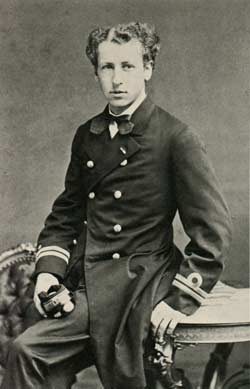
Edouard Suenson, who established the undertaking in the Far East and became the first Managing Director of the Company |
First‑Lieutenant in the Danish Navy, Edouard Suenson from 1874 the first Managing Director of the Northern and later Chairman of the Board of Directors for many years who from earlier experience of the East was acquainted with conditions in China and Japan, was appointed representative of the Extension Company in the Far East. He arrived there in May 1870 and his immediate task was to prepare the landing of the submarine cables at Hong Kong, near Shanghai and in Japan, and to organize the future operation of these cables. At the same time, the cable required for the project was being manufactured and a consignment of this cable was shipped to the Far East on the frigate "Tordenskjold" which had been made available by the Danish Navy for surveying the waters in which the cable was to be laid and for other duties. On her voyage to the East, the "Tordenskjold" was the first Danish vessel to pass through the Suez Canal. She arrived at Hong Kong in the autumn of 1870. Owing to various mishaps it was not until the spring of 1871 that a cable was successfully laid from Hong Kong to the rocky island of Gutzlaff off the mouth of the river Yangtze. From there the cable was extended along the bed of the river to Woosung and thence to the city of Shanghai. Operations on this cable commenced on the 18th of April 1871 between the Company's recently established stations in Shanghai and Hong Kong. In order to overcome the obstacle of not being able to transmit the Chinese characters directly in the Morse alphabet, the Company had edited a special "dictionary" before the opening of the telegraph service. In the dictionary each Chinese character was represented by a group of numerals which could be transmitted in the Morse alphabet. This dictionary proved of great value in the development of telegraphic correspondence in the Chinese language.
The activities in the Far East were conducted from the Company's administrative office in Shanghai which had been opened in August 187o, and the completion of the projected cable network was accomplished quickly and without serious mishaps. After the Company had opened telegraph stations at Vladivostok and Nagasaki, the Shanghai-Nagasaki and the Nagasaki‑Vladivostok cables were laid in the summer of 1871 and immediately brought into use. However, connection between the Extension Company's cables in the Far East and the Northern's cables in Europe was not established until the end of the year, when the Russian Administration had completed the construction of the Trans‑Siberian landline to Vladivostok. The route between Europe and the Far East via Russia was officially opened for public correspondence on the 1st of January 1872.
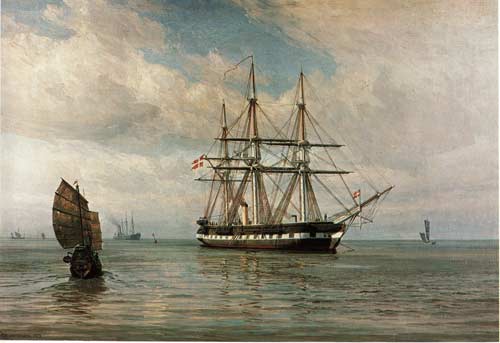
The “Tordenskjold”, the steam frigate which participated in the laying
of the first cables in the Far East. (After a painting by Vilh. Arnesen). |
After the Far Eastern cable system had been completed and connected with the European system, the Extension Company was merged with The Great Northern Telegraph Company on the 23rd of February 1872, with a Board of Directors consisting of the members of the Boards of the amalgamated companies.
The next tasks were the laying of cables between Denmark and France, and between England and Sweden. The Danish‑French cable was opened for traffic between Fredericia and Calais on the 1st of August 1873. The Northern had established its own telegraph station at Calais, and a few years later the circuit was extended to Paris. The Anglo-Swedish cable, which was brought into use in September 1873, consisted of two separate sections of cable linked by landline, one section between Newcastle and Hirtshals (Denmark), and the other between Skagen (Denmark) and Gothenburg where the Company had established a new station.
Increasing traffic, and the desire to ensure a reliable and speedy service even during interruptions of submarine cables or landlines, soon necessitated the laying of new cables. In 1877 a second cable was therefore laid between Sweden and Finland via the Aland Islands, thus giving these islands telegraphic connection with the outside world and in 1883 a third Swedish‑Finnish cable was brought into operation. In 1880 a cable was laid between Newcastle and Gothenburg, via Arendal in Norway, followed in 1890 by a direct Newcastle‑Gothenburg cable, and in 1891 the Faroe‑Calais cable was duplicated.
In the Far East, the Shanghai‑Hong Kong cable was brought in to Amoy in 1873 so that a station which the Northern had established there had connection with Shanghai and Hong Kong, and in 1883 the Shanghai‑Nagasaki and Nagasaki‑Vladivostok cables were duplicated.

Water-colour from 1894 showing the Company’s
telegraph station at Nagasaki at that time. |
In the years following the landing of the Northern's first cables in Japan, a rapid development of the Japanese internal landline network took place, and within a few years nearly the whole country was in telegraphic connection with Nagasaki and thereby with the international telegraph systems. On the other hand, the provision of connections between the cable stations in Shanghai, Amoy and Hong Kong and the interior of China proceeded only very slowly. The Company was, naturally, interested in the submarine cables being provided with feed‑lines and made great efforts in the 1870's to popularize telegraphy in China, and to awaken an interest in the construction of landlines. After considerable difficulties the work on a Chinese internal telegraph network eventually got under way in the 80's. During this period, the Northern was in charge of the building of a number of important landlines on behalf of the Chinese Government, amongst them the lines between Shanghai and Tientsin and between Shanghai and Canton. The Company also established telegraph schools with Danish instructors to train Chinese telegraphists. Furthermore, the Company acted as adviser on matters connected with organization and operation, and several of the Northern's Danish employees joined the service of the Chinese Administration.
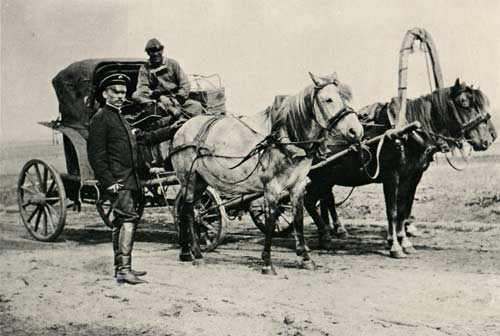
Inspection of the telegraph line in Eastern Siberia in the 1890’s |
In 1900 the Company, in conjunction with the English Eastern Extension Telegraph Company, was commissioned by the Chinese Government to supply a submarine cable system from Shanghai, via Chefoo, to Taku in North China. From Taku a landline connection was established via Tientsin to Peking. In addition, some short local cables were laid in North China, amongst them a German cable from Chefoo to Tsingtao which was connected with Shanghai by another German submarine cable. The Northern opened telegraph stations in Chefoo, Tientsin and Peking and participated in the operation and maintenance of these cables for some years, in the case of the Shanghai‑Chefoo‑Taku system until 1934 when the Company's stations in North China were taken over by the Administration.
In 1897, the Northern entered into negotiations with various parties concerning the laying of a cable to the Faroe Islands and Iceland. Besides providing the population there with telegraphic connection to the outside world, this cable would be of considerable importance for the transmission of' weather reports from the North Atlantic area to the meteorological services of many countries. However, several years were to pass before a basis for implementing this project could be found. Not until 1906 was the Company able to open the system which consisted of a cable between the Shetland Islands, which already had a cable connection with Scotland, and Thorshavn, and another between Thorshavn and Seydisfjord on the cast coast of Iceland. The Northern opened telegraph stations in Thorshavn and Seydisfjord, and the same year a landline was established over the northern part of Iceland from Seydisfjord to Reykjavik.
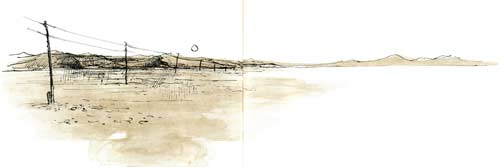
The telegraph line between Kiachta and Peking spanned the Gobi Desert. |
The following year brought a new Danish‑Russian cable system consisting of cables between Stevns (Denmark) and Liepaja, and between Liepaja and the present‑day Leningrad. By 1907 the Northern's submarine cables in Europe and the Far East (shown on Chart 1907 together with the most important connecting landlines) had reached a total length of some 15,600 kilometres, not including the cables in North China which were partly operated by the Company.
The Danish‑Norwegian and the Anglo‑Norwegian cables were transferred to the respective State Administrations at the end of 1910, but other new cables were commissioned. A fourth Swedish‑Finnish cable was laid in 1911 and the Anglo‑Danish cable was duplicated in 1913. By now, the Northern had organized its cable systems in Europe and the Far East in such a way that the effects of cable interruptions could be mitigated by diverting the traffic to cables in working condition, and interruptions therefore seldom caused delay in the transmission of the traffic. Parallel with the expansion of the cable network, a progressive improvement took place with regard to the technique used on the Company's circuits. Over the years the technical development resulted in greatly increased efficiency of the cables, and also made direct working possible over ever greater distances without intermediate retransmission of the telegrams. The Northern was thus well prepared to handle the increasing telegraph correspondence, and nearly 40 years elapsed before it was necessary for the Company to establish new cable systems.
The link between the Northern's European and Far Eastern systems, the route transiting Russia and Siberia, has played a particularly important role in the Company's hundred years of activity. The construction of the 10,000 kilometres of overhead line from Western Russia to Vladivostok had made very heavy demands in the 1860's on the linemen of the Russian Administration. The line had to be carried through long stretches of uninhabited forest regions and mountain areas and over wide rivers and through river valleys. The severe climatic conditions presented a multitude of difficulties to the maintenance of the line, especially in Eastern Siberia where floods and drift ice frequently caused extensive damage. However, in the course of time, these difficulties were over come to such an extent that the connection through Russia and Siberia functioned with a stability that was remarkable for an overhead line of this length. Whilst the cables at Liepaja and Nystad in the West and Vladivostok in the East were operated by the Northern, the traffic transiting the Russian landlines between these towns was for many years handled by the employees of the Russian Telegraph Administration. Close co-operation took place, however, between the Government officials and the Company, especially in the technical field, where constant efforts to improve the efficiency and the quality of transmission resulted in making the Siberian route the fastest between Europe and the Far East. Until shortly after the turn of the century, all the Northern's traffic between Europe and the Far East, including telegrams to and from China, was carried over the Vladivostok‑Nagasaki cables; but in 1904 the so‑called Kiachta route was opened. This route consisted of a connection from Irkutsk via the Russian border town of Kiachta where the Company set up a relay station‑through Mongolia to Peking and on to Shanghai via Chefoo and the previously mentioned North China cable system. The Northern's station in Peking operated the line there, and when the Company established its own stations in Leningrad and Irkutsk in 1904 and 1907 respectively, the stage had been reached where traffic between China and England was subjected to only two intermediate re‑transmissions, namely at the Company's stations at Irkutsk and Leningrad‑a considerable achievement in those days. The Kiachta route was opened just as the route via Vladivostok‑Nagasaki became unusable as a result of the Russo‑Japanese war, and the Company thus avoided a prolonged total interruption of the connection between the European and Far Eastern cable systems. The Kiachta route also became of very great importance in later years, partly because it was the shortest telegraph connection between Europe and North China and partly because it constituted a valuable reserve for the Vladivostok route when the severe climatic conditions of Eastern Siberia caused interruptions between Irkutsk and Vladivostok.

1907 route map |
The expansion of the Northern's telegraph network, and the operational improvements on the circuits were followed by a progressive increase in the volume of traffic handled by the Company. It should be noted, however, that this prosperity was not derived from the Company enjoying any kind of monopolistic protection. In Europe it was customary for the Governments, who granted cable concessions to the Northern, to safeguard the Company against competition from other submarine cables in Europe. These safeguards did not, however, protect the Company against competition from the state owned landlines on the Continent which in many cases offered alternative routes to the Company's cable routes. In the Far East, the Vladivostok‑Nagasaki‑Shanghai‑Hong Kong cables were subject to competition from internal Chinese landlines and from connections across the frontier between China and Russia. As regards telegrams to and from the Far East, this traffic was transmitted not only by the Northern but also by the English Eastern Extension telegraph company. This company reached China by means of a submarine cable via India at about the same time as the Northern had extended its activities to China. From the beginning of the century a cable system established across the Pacific between the Far East and America also participated in the transmission of the traffic in question.
Apart from the development of the telegraph network, the growth in telegraph traffic was, of course, mainly contingent on the expansion of international trade and shipping, and in no small degree also on the increasing demand from the Press for speedy news coverage. The growth in traffic was, however, also stimulated by frequent and very considerable reductions in the telegraph rates. These were agreed either at international telegraph conferences between the member countries of the Telegraph Union or directly between the Northern and the Governments who granted the concessions.
The First World War and the Inter‑War Period
Competition from Radio Connections,
Recession
DURING THE FIRST WORLD WAR, the Northern was on the whole able to continue its normal activities; but eventually several of the Company's European cables became interrupted in areas where repairs had to be deferred owing to the presence of minefields and to wartime conditions in general. The extra capacity which the development of the cable network and the continued improvements in technology had provided, now stood the Northern in good stead, and in spite of the cable interruptions, the Company was even able to handle a greatly increased volume of traffic. The growth in traffic was particularly large over the Company's European system. The war had slowed down the international postal services, and the almost total ban on the use of code language resulted in an increase in the number of words used in the telegrams. Towards the end of the war, however, the volume of traffic over the Northern's European system declined to some extent. Furthermore, the October Revolution in Russia and the ensuing civil war caused, in the spring of 1918, a complete suspension of the telegraph connections with Leningrad and the closing of the transit route via Russia and Siberia, and for a time the Company lost the connection between the European and the Far Eastern networks. The Baltic cables to Liepaja had already been interrupted earlier in the war.
In January 1918, after Finland had become independent, a telegraph connection was established over the Company's Swedish‑Finnish cables between Stockholm and Helsinki where the Northern immediately afterwards opened a telegraph station. In January 1919, the Company's station at Liepaja in Latvia was re‑opened and this station, together with a new one that was opened at Riga the following year, resumed operations with Fredericia on the Moen‑Bornholm‑Liepaja cable.

The Company’s building in Shanghai. |
The telegraph connection between the Northern's stations at Gothenburg and Leningrad was re‑opened in January 1922. Later that year the connection was extended to Moscow where the Northern was to open a telegraph station in accordance with the concession granted to the Company by the Soviet Government in 1921. In 1923 a direct telegraph connection between Fredericia and Leningrad over the Stevns‑Liepaja‑Leningrad cable was opened. The connecting line between the Northern's European and Far Eastern cable systems was re‑established in March 1922, after having been interrupted for nearly 4 years. Initially the line was carried by a new route via Leningrad - Irkutsk - Blagovestchensk - Helampo ‑ Harbin to Peking, but shortly afterwards also by the old routes that had been used before the war, Irkutsk - Kiachta ‑ Peking and Irkutsk - Vladivostok - Nagasaki. However, owing amongst other circumstances to the political situation in China, the Helampo and Kiachta routes had to be relinquished in the middle of the 1920's. In their place a second line between Irkutsk and Vladivostok was made available to the Northern, who then had two through connections between Leningrad and Vladivostok. For a number of years the Company operated certain technical supporting stations on the Trans‑Siberian transit route. The route was continually being improved so that direct working over ever greater distances became possible and the efficiency of the telegraph service thereby increased. By 1932 direct working between Leningrad and Nagasaki was introduced; at that time the longest combined cable and overhead‑line circuit in existence. In 1937 the Europe‑Far East transit route was further improved by the introduction of direct working between the stations in Helsinki and Nagasaki. At the same time, the efforts to increase the speed and stability of the service were also continued on the European and Far Eastern systems. Consequently, the Company was well armed as far as the quality of the service was concerned, when new forms of competition arose as a result of the development in radio communication.
The radio circuits that were opened before the First World War were so few in number and so unstable in operation that they had not been able seriously to compete with the cable circuits. During and after the war radio techniques were considerably improved and in the years following a great number of new international radio telegraph circuits was opened. The growth of international telegram traffic, which especially during the first half of the 1930's suffered from the world‑wide economic crisis, did not keep pace with the additional capacity provided by these new circuits, and increased competition for the available traffic resulted. The competition affected the Northern both in respect of traffic within the European and Far Eastern areas, and in respect of traffic between the countries served by the Company's European cables and overseas countries, especially the Far East and America. In the competition between the cable and radio routes the cables were well able to hold their own in respect of stability and speed, and as they moreover competed on equal terms with the radio as regards charges, they were widely preferred by the public. Nevertheless the competition from the predominantly state owned radio routes gradually became exceptionally severe for both the Northern and the other cable companies. This was mainly due to the fact that the State Administrations, in addition to being financially interested in favouring the radio routes, were often able to decide, or at least to influence the choice between cable and radio routes.
At the same time as the rapidly increasing number of international radio telegraph circuits was limiting the volume of traffic on the Company's cables, the economy of the cables was further weakened by declining telegraph rates, mainly for inter‑continental traffic, and by rising operating costs. However, the Company sought as far as possible to reduce the effects of these factors by technical improvements and by rationalization of the service.
The Second World War and the Post‑War Period.
Restoration.
New Developments.
THE SECOND WORLD WAR soon created severe difficulties for the Northern, and by the end of 1941 almost all the Company's operations had come to a standstill. When the war was over all the cables in the Far East were interrupted, and in Europe only the cables between England and the Faroes and Iceland, and between Sweden and Finland remained intact. Furthermore, the war had prevented the Company from negotiating the renewal of several important concessions and agreements which had expired during the period of hostilities. Much work was therefore to be done in connection with the renewal of agreements for the resumption of the Company's operations, and with the re‑establishment of the cable systems in Europe and the Far East and the connecting link between these, the transit route through the USSR.
The repair of the cables in European waters started immediately after the war ended in May 1945. Many difficulties were encountered because of the extensive mine laying that had taken place during the war. However, the naval authorities in Denmark, England, Finland, Sweden and the Soviet Union acknowledged the importance of an early re‑establishment of the cable connections. Despite the pressing need of the shipping routes for safety, the minesweeping services of these countries gave the Company valuable assistance by sweeping the areas where the cables were interrupted. Although extensive precautions were taken to safeguard the repair vessels, the cable ship "Karla" was unfortunately struck by a mine on the 1st of January 1947 during cable repair work in the Gulf of Finland, and 16 members of the crew lost their lives.
Within a few months of the end of hostilities, the Northern's cables between England, Denmark, Sweden and Finland were again in service, and in 1946 the connection with the USSR was re‑established. The direct circuit between Denmark and France could not be restored until 1947 as the Company's cable station at Calais had been completely destroyed during the war. After the signing of a new agreement regarding the resumption of the Northern's operations with Japan, and after the restoration of the Nagasaki‑Vladivostok cables, the Company re‑opened in 1948 the telegraph connection between Europe and Japan via the transit route through the USSR. For the first few years this connection consisted of one Helsinki‑Nagasaki circuit only, but later another circuit was added, and gradually the stability and speed of transmission of the system reached an even higher level than that attained before the war.
The other cable installations of the Northern in the Far East were also restored, and staff was held in readiness for the service to be re‑opened at short notice. However, several years of negotiations failed to create the basis necessary for the resumption of the Company's activities in China. When conditions there gradually changed to such an extent that further efforts seemed futile, the only course left was to make an agreement with the Chinese authorities to wind up the Company's interests.
Whilst the Northern had thus met with disappointments in China, where the Company had contributed so much to the introduction and development of the telegraph service, new challenges presented themselves in the West during the years after the Second World War.
In 1948, a direct cable circuit was established between Poland and Denmark by utilizing two existing Poland‑Bornholm cables which were made available for the purpose in conjunction with a new cable which the Northern laid between Bornholm and Zealand, thus providing Poland with a fast and reliable cable telegraph connection with the countries served by the Company.
After the Second World War the demand for international telecommunication services grew considerably. This was especially due to the international Telex service which had been introduced between a few countries even before the war and had rapidly gained popularity with the public. As the inland Telex networks of the various countries were developed and the necessary international line capacity was provided, this service stood on the threshold of a considerable expansion. The demand for line capacity for the public telegraph network was also growing. In addition, customers with a particularly large international correspondence were realizing the advantage of leasing telegraph channels for their own use instead of using the public telegraph and Telex services.

From the Company's building in St. Helen's Place in London. |
Submarine cables of the conventional type such as those hitherto used by the Company and normally containing only a single telegraph channel, were still providing public for the Telex service and for privately leased circuits. However, a new type of cable had been developed and was being used for submarine connections, the so‑called Coaxial Cable. In the course of a few years the coaxial cable was to become an extremely important factor in international and intercontinental telecommunications. The coaxial submarine cables could provide a much larger line capacity than the conventional cables, and it soon became possible to expand their capacity further by inserting submarine repeaters. Although the total cost of construction of a coaxial cable was considerably higher than that of an old type cable, channels could now be provided at a lower cost than had hitherto been
possible.
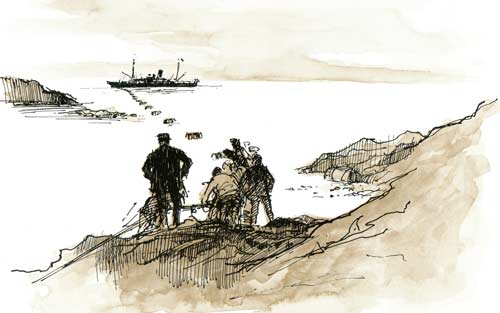
The landing of a cable |
In order to obtain the increase in channel capacity which was essential for the participation of the Northern in the new telecommunication services, and also in order to rationalize the operation of the public telegraph circuits, the Company began replacing the old cables by cables of the new type. As the first stage in the modernization programme, the Northern laid a coaxial submarine cable between Denmark and England as a replacement of three cables of conventional design. When the new cable was inaugurated in 1950 it was the longest coaxial submarine cable in existence. At first it contained 24 telegraph channels, but some years later submarine repeaters were inserted and the capacity of the cable was expanded to 192 channels which are used partly for the Telex service and public telegraph circuits, and partly for privately leased circuits.
Besides providing a substitute for the three Anglo‑Danish telegraph cables, the new cable was later to replace the Company's two Danish‑French cables, the direct telegraph connection between Denmark and France being transferred to the coaxial cable and lines between London and Paris. After agreement with the Administrations of Sweden and Finland, the Company was also able to abandon the four old submarine cables between the two countries, and to transfer the telegraph circuits from these cables to channels made available in a Swedish‑Finnish telephone cable.
As mentioned above, the Northern's Anglo‑Danish coaxial cable was laid with a view to providing telegraph channels both for the public telegraph connections and for the Telex and privately leased services. The development of the submarine repeaters meant, however, that new coaxial submarine cables could be designed with a channel capacity sufficient also to meet the demand of the telephone service, and new submarine systems were therefore established as combined telephone and telegraph cables. The channels to be used for telegraph and Telex circuits were provided by converting telephone channels into a larger number of telegraph channels, as and when demand arose. The increased line capacity in repeatered coaxial submarine cables made it possible to satisfy the channel requirements of more than one Administration, and quite often it was not the same Administration which provided the facilities for the international transmission of both telephone and telegraph traffic. For these reasons co‑ownership and joint operation of new coaxial systems became common practice, just as it was not unusual for Administrations to lease facilities in systems owned by other Administrations.
When a coaxial cable system for telephony and telegraphy was established in 196o between Denmark and Poland to replace the Company's direct telegraph connection opened in 1948, the principle of co‑ownership was followed. The Danish and Polish Administrations and the Company laid a jointly‑owned cable from Poland to Bornholm from where the connections were carried in a new Danish coaxial cable between Bornholm and Zealand. The new Danish‑Polish cable, which has a capacity equal to 60 telephone channels, provided the two Administrations with facilities for the telephone service, whilst the Company, besides improving and expanding its telegraph service with Poland, acquired line capacity for Telex and privately leased circuits.
When a combined telephone and telegraph cable, jointly owned by the British and Swedish Governments, was brought into service in the autumn of 196o, the Northern arranged to lease a number of telegraph channels in the cable. The Company was then able to abandon its two remaining old North Sea cables, the Anglo‑Swedish cables, which had become excessively expensive to maintain.
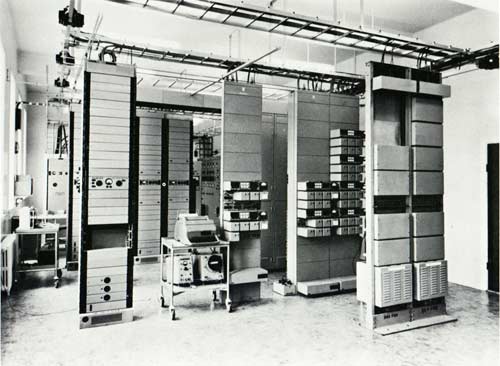
The Iceland Telecommunications Administration’s repeater
station in the Vestmanna Islands which houses terminal
equipment
for the Scotice and Icecan cables. |
The next step in the renewal and expansion of the Northern's submarine cable network was the laying of a coaxial cable for telephony and telegraphy between Scotland and Iceland via the Faroes, the so‑called Scotice system, which replaced the telegraph cable laid in 1906. The Scotice system, which has a capacity equal to 24 telephone channels, was also established on the basis of co‑ownership and joint operation. The British Post Office became joint owners with the Company of the section between Scotland and the Faroes, and the Iceland Administration provided the link from the landing point on the Vestmanna Islands to Reykjavik, whilst the Danish Post and Telegraph Administration participated in the system with a share equivalent to the requirement of telephone channels to the Faroes. When the new system was brought into service in January 1962, Iceland and the Faroes gained access by cable to the international telephone and Telex network, and it became possible to lease a number of telephone and telegraph channels to the International Civil Aviation Organization. The Northern's international service had previously been limited to transmission of telegrams, provision for transmission of Telex traffic and leasing of telegraph circuits, but with the opening of Scotice, the Company acquired for the first time a share in the transmission of international telephone correspondence and in the leasing of telephone channels.
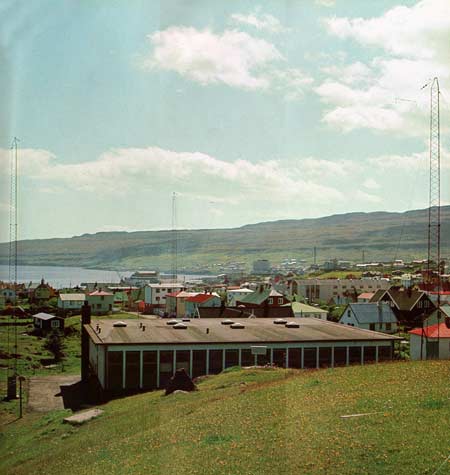
Thorshaaven station |
The demand of the Civil Aviation Authorities for better communication facilities had helped to create the economic basis for establishing Scotice, and the same requirement became decisive for establishing the next cable system, Icecan, a coaxial cable which extends Scotice westwards by connecting Iceland (Vestmanna Islands) with Greenland and Canada. The cable is landed at Frederiksdal, on the south west coast of Greenland. At Frederiksdal the Northern has built and manned a cable station from where cables and VHF radio links carry the Civil Aviation Authorities circuits to Prins Christians Sund on the east coast. Icecan is jointly operated by the Northern and the Canadian Overseas Telecommunication Corporation, the latter being co‑owner of the cable section between Greenland and Canada. The cable system, which is a little over 3,000 kilometres long, was brought into service at the New Year of 1963 and, like Scotice, has a capacity equal to 24 telephone channels. Some of these are used for carrying public telegraph, Telex and telephone traffic, and others are available for lease to various users, amongst them the Civil Aviation Authorities.
The landing of the cables at Frederiksdal proved an extremely difficult task, and for some time after the opening of Icecan, the system was frequently damaged near the coast of Greenland by large icebergs which, carried by wind and currents, grounded on the cables, at times at a depth of several hundred metres. In order to overcome these difficulties, it was necessary to introduce new methods of securing the shore‑ends of the cables. One method was the re‑laying of the cables to a point on the coast where they could be landed from a depth of 100 metres through steel‑lined ducts, 200 metres long, which had been drilled through the rock. By this means marked improvements were obtained and cable interruptions caused by grounded icebergs are now of rare occurrence.
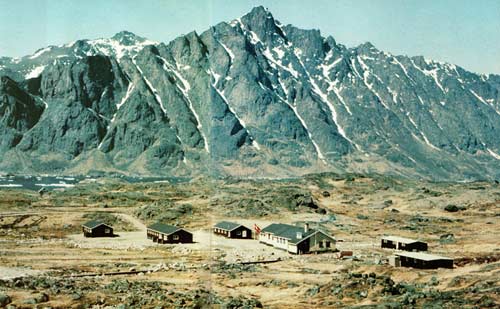
The Company’s cable station at Fredericksdal,
on the south west coast of Greenland. |
In 1967, after several years of negotiations, the Ministry for Posts and Telecommunications of the USSR, the International Telecommunications Company of Japan‑Kokusai Denshin Denwa Company and the Northern entered into an agreement concerning the modernization of the telecommunication connection between Europe and the Far East via the USSR, the connection dating from 1872 providing for transmission of telegrams only. The three parties agreed to establish jointly a new direct high capacity telecommunication system between Europe and the Far East to be used for telephony, telegraphy and Telex. The system will have a capacity equal to 120 telephone channels, and will consist of a coaxial submarine cable from Naoetsu in Japan to Nakhodka in the USSR, provided jointly by the Japanese company and the Northern, and line facilities through the Soviet Union made available by the Ministry for Posts and Telecommunications. The system will be by far the shortest cable connection between the Far East and Europe. It is expected to be ready for service at the time of the Northern's Centenary.
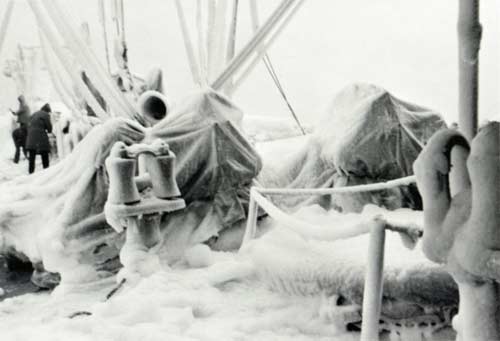
The cable ship Edouard Suenson at cable
work
in the North Atlantic, February 1968. |
When the coaxial cable between Naoetsu and Nakhodka is brought into service, the Company's two old submarine cables between Nagasaki and Vladivostok will no longer be required, and the replacement of the old telegraph cables by modern communication facilities will be completed. Chart 1969 shows the coaxial cable systems that are owned, wholly or partly, by the Northern at the time of the Company's Centenary, together with the overland connections. Although the number of cables is now smaller than that shown on Chart 1907, the traffic‑carrying capacity at the Company's disposal has increased many times over. Furthermore, modernization of the communication facilities has enabled the Company to expand its activities from the carrying of telegrams only to the participation in the provision of Telex and telephone services and the leasing of circuits. Finally, the modernization has permitted a thorough rationalization of the service.
For some time after the Second World War, the competition from radio connections, particularly over long distances, continued to manifest itself. However, the large capacity and the reliability of the coaxial cable systems gradually brought about a shift in the competitive position in favour of the cables. To a certain extent the international airmail services also entered into competition with the telegraph services but, in particular, competition arose from the international telephone services. The latter services increased in importance year by year and made remarkable progress in fields where the radiotelephone phone connections could be supplemented and partly replaced by telephone channels in coaxial cable systems.
In spite of competition, the telegraph traffic carried over the Northern's connections increased in volume for some years after the war, but was later, both within Europe and between Europe and the extra‑European countries, influenced especially by the Telex service which to some extent expanded at the expense of the public telegraph traffic. This development was unfavourable to the Northern, as the Company only partially benefited from the Telex traffic which replaced the telegraph traffic carried on the cables. The North Atlantic cable system and the other coaxial cables of which the Company is part owner have, however, offered new sources of revenue, the most important being the leasing of telephone and telegraph channels.
Although the level of costs and prices in general has been rising since the Second World War, telecommunication rates have in the same period continued to decrease, and certain changes have taken place with regard to the division of the rates amongst the parties engaged in international telecommunication. The share of the rates allotted to the terminal countries has been increased at the expense of the share allotted to the transit administrations. The Northern is to a large extent providing transit connections for the telecommunication traffic and the changes in the rate division have, therefore, been to the disadvantage of the Company.
In the early 1960's, radio connections of a new type were introduced, microwave links via satellite. This technique has been subject to a very rapid development towards providing a world‑wide communication system with large traffic capacity and of a quality far exceeding that of the short‑wave radio links. Communication by satellite will be of particular importance over the long distances between the continents, and it is widely held that in this field cable and satellite connections will, for a long time to come, supplement each other in satisfying the fast‑growing demand for telecommunication services. It must be expected, however, that concurrently with the satellite links being expanded to ever greater transmission capacity, they will exert a considerable influence on the telecommunication rates, and in this way also affect the revenue to be derived from the cables.

Part of the Company’s telegraph station in London. |
Maintenance of the Cables
SHORTLY AFTER the Company's first cables had been laid it became evident that they were not to be left undisturbed at the bottom of the sea. At first damage to the cables was mainly caused by ships anchoring, but as early as the 1870's the first faults and breaks caused by fishing trawlers occurred in the North Sea, and trawling soon became the most serious hazard to the submarine cables. Incidents of trawl damage soon spread to all the European and Far Eastern cables, and increased in number with the growth of the trawler fleets and with the ability of the trawlers to fish in deeper waters. Over the years, the Northern and other cable owners have tried in various ways, individually and in co-operation, to protect the cables from damage caused by trawling: by distributing information to the fishing organizations and the trawler owners; by attempting to have the trawl boards designed so as to present the least possible danger to cables; by removing cables from areas where intensive trawling takes place and, when practicable, relaying them at greater depths where trawling does not take place; and by using heavily armoured cable in particularly exposed sectors. But despite all these efforts, trawling is still the most frequent cause of damage to the cables. The risk of interruptions to the cables landed in Greenland, due to the grounding of icebergs on the cables, has been mentioned previously. In Far Eastern waters, the cables have at times been subject to a special kind of interruption, namely the picking up and theft of sections of submarine cable for the purpose of selling the armouring wire and copper cores. As late as 1950 a length of approximately 100 kilometres was stolen from one of the Northern's cables off the Korean coast.
During the first few years of the Company's existence, the maintenance of the cables in European and Far Eastern waters was carried out by chartered vessels, but in 1872 the Company established its own cable maintenance service.
The “H. C. Oersted”, 716 GRT, was the first ship ever to be built especially for cable repair work. She was completed in 1872 and immediately afterwards stationed at Shanghai. In 1881 she was transferred to Copenhagen for maintenance of the European cables, and was replaced in the Far East by the first of the Company's cable ships to be named “Store Nordiske”, 832 GRT. This vessel had been built in 1880, and was in service in European waters for a short time before being stationed at Shanghai in 1881.
With the laying of the cables between Shanghai and North China in 1900 the maintenance duties in the Far Eastern waters increased to such an extent that it became necessary to station a second cable ship there. This ship, the “Pacific”, was built in 1903. With a displacement of 1570 GRT she was considerably larger than the older cable ships.
When the “H. C. Oersted” was taken out of service, the maintenance of the submarine cables in Europe was assigned to a new cable ship, the “Edouard Suenson”, 1552 GRT. She was built in 1922 and operated from Copenhagen until 1968. In the Far East, the first “Store Nordiske” was replaced by a new "Store Nordiske, 1456 GRT, built in 1922. When the old Nagasaki‑Vladivostok cables have been replaced by the new coaxial cable between Naoetsu and Nakhodka, this cable will be maintained by the “KDD Maru”, built in 1967 and belonging to the Kokusai Denshin Denwa Company. The “Store Nordiske” which has been stationed at Hong Kong since the Second World War, will then be taken out of service.

The Cable Ship “Pacific” which for many
years was
on duty in Far Eastern waters. |
To assist the "Edouard Suenson" in re‑establishing the European cable network after the Second World War the s/s “Karla”, a freighter acquired during the war, was converted into a cable ship in 1945. As mentioned earlier, the “Karla” sank in the Gulf of Finland on the 1st of January 1947 after being struck by a mine.
In 1967, the Northern purchased the m/s “Sirpa Dan” as a replacement of the “Edouard Suenson”. The “Sirpa Dan” was built in 1962, is reinforced against ice and has a displacement of 1768 GRT. After being converted into a cable ship and renamed “Northern”, she was commissioned in 1968.
Permanent cable depots were established at Woosung near Shanghai, and at the harbour of Tuborg near Copenhagen for the storage of spare cable and repair equipment necessary for the maintenance of the cables. In 1919, the depot at Tuborg was transferred to the Free Port of Copenhagen.
Besides maintaining the Company's own cables, the Northern's cable ships have frequently been chartered to other telegraph companies and Administrations in Europe and the Far East both for repair work and for the laying of new cables.
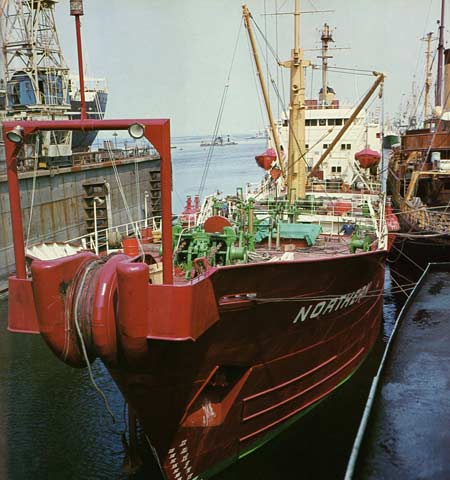
The Cable Ship “Northern” at Aalborg
Shipyard in the summer of 1968. |
Personnel
DURING THE FIRST FEW YEARS after the formation of the Northern, the telegraph stations in Europe were staffed by employees of the Danish Government Telegraph Administration, who were released from service there; but with the commencement of operations in the Far East, the Company began training its own staff. For a number of years, however, the Danish Administration gave the Northern considerable assistance in the training of staff. Newly‑employed young Danes gained their first practical experience as telegraphists at the Government station at Fredericia before being transferred to one of the Company's stations abroad for further training. This practice continued until 1910 when a telegraph school was established at the Company's Head Office in Copenhagen. At this school the Danish telegraphists could be given a more uniform theoretical and practical training than they had been able to obtain at the various stations.
As a general rule personnel for the administrative offices were recruited from the ranks of the telegraphists, from where staff were also drafted for training as engineers and technicians at Head Office, at the stations and on the cable ships.
Whilst the stations abroad were initially manned by Danish staff, recruiting commenced in the late 1870's of male staff, and later also of female staff, in the countries where the stations were situated. Nowadays, nearly all the employees dealing with the transmission of telegrams are locally engaged as, to a great extent, are those who maintain the local technical services.
Over the years the Company's staff requirements have changed in accordance with the alterations in the working conditions which have been caused by new techniques and by practical and other considerations arising from the co-operation with other companies and Administrations.
The main features of the development are the ever progressing automation and the accomplishment of transmitting direct over ever longer distances which have greatly reduced the number of manual operations required and thereby the demand for staff.
Apart from the alterations caused by new techniques, changes have taken place in the division of work between the Company, the Administrations and other companies. These changes have occurred partly within the field of structural reorganization and partly in order to meet the Administrations wishes concerning the division of the work, all resulting in the closing down of telegraph stations previously operated by the Company and the operations being taken over by the respective Administrations. To this must be added the changes caused by the disappearance of certain fields of activity, especially China, and the appearance of new fields of activity.
Employees of the Northern have through the years invented a number of telegraph instruments which have increased the efficiency of the Company's service and have also left their mark in the field of international telegraphy generally. Amongst these inventions can be mentioned Lauritzen's Undulator, a receiving instrument which was introduced on the cable circuits in Europe and the Far East as early as 1876, and Gulstad's Cable Relay, which came to be extensively used, and which for example made possible a considerable increase in the transmission speed on the cables. This cable relay and the Rotating Drum Regenerator were instruments that amplified and rectified telegraph signals received through cables and landlines over long distances. The Rotating Drum Regenerator was one of the factors essential to the establishment of the previously mentioned long direct circuits between Helsinki and Nagasaki.
New Spheres of Activity
THE LINES ALONG Which the policy of the Northern was directed for three quarters of' a century may be characterized by the old saying "Cobbler, stick to your last". There was no tendency to enter other areas of activity than that of telecommunication.
The reason for this was mainly that for a very long period until some years after the First World War the financial results of the telecommunication activities were extremely good. It may also have been of importance that the Company's prosperity and the fact that its activities were conducted in close co-operation with Government authorities could not avoid giving the Company a certain Institutional character.
The large reserves were almost exclusively invested in "gilt‑edged" bonds which were distributed among various countries and currencies in keeping with the international position of the Company.
The events of the thirties, which was a period of stagnation for the Company's telecommunication activities, and the growing threat of a world‑wide war, formed the background for a re‑orientation of the Company's policy as regards the utilization of its assets and resources.
The first steps were taken shortly before the Second World War when it was decided to try to effect a greater diversification of the Company's investments outside the area of telecommunications by the transfer from bonds to real estate and equities. This was not done without some reluctance within the management, and for this reason and also for practical purposes the change was made gradually. The investments in equities are aimed at obtaining a wide spread over a variety of industries with a certain preference for undertakings whose fields of activity are closely related to that of the Company as indicated in the Company's Articles of Association. As far as possible a geographical spread has also been maintained, as may be seen from the Company's annual reports.
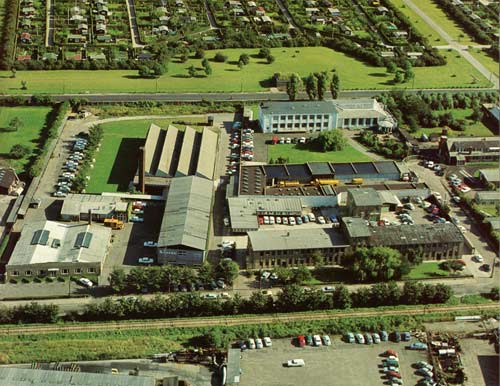
Office buildings and laboratories of STORNO A/S, Copenhagen. |
By these investments the Company has to a certain extent avoided the inroads into the real value of the assets that have befallen all holders of bonds through the depreciation of the purchasing power of the Danish krone and other currencies.
In parallel with the new orientation of the administration of the Company's investments outside the telecommunication area, the idea germinated of utilizing the Company's resources in a more active way by entering into industrial activities. This began with an expansion and renewal of the Company's production of telegraph instruments and other electro‑mechanical equipment.
The majority of the telegraph instruments needed for the Company's service were at first purchased abroad, but in 1875 the Company established its own workshop in Copenhagen. From a modest beginning, the workshop expanded to the extent that it was able not only to manufacture and maintain practically all the telegraph apparatus used by the Northern, but also to develop the sale of instruments to telecommunication administrations in a number of countries. During the Second World War, a considerable production of telegraph instruments was started in England by the local workshops attached to the Company's stations in London and Newcastle. In the course of time the Company's telegraph instruments had gained such a high international reputation for quality and reliability that an expansion in this area of activity by means of more advanced industrial methods was considered justified. In 1949, a telegraph instrument factory, GREAT NORTHERN TELEGRAPH WORKS, was established in Copenhagen, and the manufacturing programme of this factory has gradually been supplemented by new types of instruments, the latest being a teleprinter designed and developed by the factory and various new instruments for use in electronic data transmission.
On the 1st of January 1968, Great Northern Telegraph Works amalgamated with Telefon Fabrik Automatic A/S in which company the Northern acquired a little over fifty per cent. of the share capital, the remainder of the capital being owned by Telefonaktiebolaget LM Ericsson of Stockholm. The new company, which was named GNT AUTOMATIC A/S, continues the production of the two amalgamated factories.
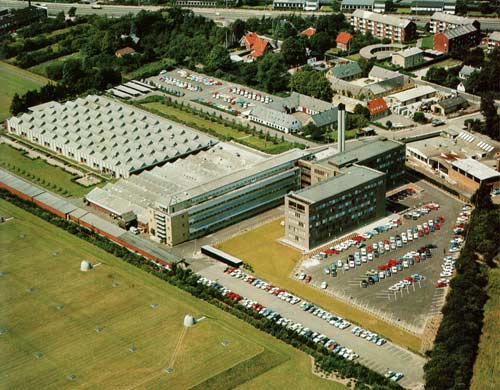
GNT AUTOMATIC A/S, Gladsaxe near Copenhagen. |
In 1947, the Company established a manufacturing division for the production of radio communication equipment under the name of STORNO. During the war an interesting development had taken place in the USA with regard to ultra‑short‑wave radio communication, especially by application of the so‑called FM technique. There was reason to expect that a considerable demand for similar systems of communication would develop on this side of the Atlantic, and as there were Danish electrical engineers available who had an extensive knowledge of the new technique, the Company decided to go ahead with the new undertaking.
At first, Storno manufactured both mobile radio communication equipment and various related products such as equipment for micro‑wave links, for mobile and fixed broadcasting stations, and for airport systems.
In 1959, a detailed analysis of the world‑wide demand for mobile radio telephone systems led to Storno's activities being concentrated in this field. Today, Storno's activities are devoted exclusively to the development, production and sale of mobile radio telephone systems, in which sphere the factory, even by international standards, has gained a prominent position with an annual turnover of 100 million kroner.
Despite the rapid growth of Storno's activities, the expansion of the firm has not taken place without certain difficulties. From the very beginning Storno was orientated towards export. For a young business in a small country that does not offer the support of a strong home market, it is an exacting task to introduce technical products of high quality on to the world market. In order to gain a foothold for a product almost unknown to the customers, it is necessary to sell at the lowest prices quoted by the competitors.
But gradually, the quality of design and workmanship which characterizes Storno's products has become internationally recognized. Whilst keen international competition still prevails in Storno's field of business, the annual increase in the demand for communication equipment has been, and seems likely to continue to be, considerable.
The traditional customers are police forces, fire brigades, railways, tramways, hire car companies, ambulance services, power stations and similar undertakings. However, mobile and portable radio telephones have a much wider use today with the growing need of industry for rational transport control. In many countries the authorities have established base‑stations for mobile radio telephone systems through which the motorist can be connected to the public telephone system, and in this way can communicate with subscribers throughout the world from his own car. Storno's systems are in operation in all parts of the world and under all climatic conditions. During recent years, 85 per cent. of the total turnover has been for export.

A/S HELLESENS, Factory at Koege (near Copenhagen)
for mass production of dry batteries. |
In 1968, the factory was made a limited company under the name of STORNO A/S with a share capital of 20 million kroner, the total of which is held by the Northern. There are subsidiary companies in England and in Sweden, and in 1967 a subsidiary company was established at Flensburg in West Germany especially for sales within the Common Market.
Amongst the Company's industrial interests A/S HELLESENS should also be mentioned. In connection with the re‑distribution of investments referred to above, the Northern acquired part of the share capital of A/S Hellesens in 1939, and this holding has gradually been increased to the extent that the Northern now owns practically the whole of the share capital.
The 80‑year old firm of A/S Hellesens, which manufactures and sells dry batteries originally based on an invention by the Dane W. Hellesen, has since the Second World War developed considerably both technically and commercially. The production programme comprises dry batteries for almost every purpose. Two‑thirds of the turnover, which now amounts to 65 million kroner annually, is for export.
Share Capital and Dividend
AS EARLY as the seventies, the revenue from the telecommunication activities made it possible for the Northern to create a reserve fund, and this policy of consolidation was continued over the years. Thanks to the considerable reserves, duplication of the cables and other expansions of the system could be financed by the Company's own resources, supplemented during the first few years by two loans which were fully repaid in 1899. During the long period from 1872 to 1928 the share capital remained unchanged at 27 million kroner.
The revenue and the dividend increased with the growth of the Company's net assets and the volume of business. As the share capital remained constant the dividend gradually grew to 2o per cent. and more, a circumstance which in later and less favourable years gave rise to erroneous conceptions regarding the earnings connected with the telecommunication activities.
For many years, interest on the reserves was not placed to the credit of the revenue account, but was added to the reserve fund. This practice was changed in 1928 when THE GREAT NORTHERN TELEGRAPH COMPANY's HOLDING COMPANY was founded. By way of capitalization of reserves the Telegraph Company's share capital was increased by 9 million kroner, and the new issue was transferred to the Holding Company whose shares were in turn surrendered to the shareholders of the Telegraph Company.
The Company's dividend policy has been characterized by stability. For a long period, up to the Second World War, the dividend remained constant at 20 per cent. During the war years, when most of the Northern's activities gradually came to a standstill and the Company's head office had no contact with the branches abroad, no dividend was paid. After the war, the payment of a dividend was resumed, but during the following years of poor financial results, the dividend was gradually reduced to 7 per cent. Later, when. financial results improved the dividend was gradually raised to 12 per cent.
During the first few years after the war, the revenue was insufficient to meet the payment of the dividend, and all in all the direct and indirect effects of the war resulted in a considerable reduction of the Company's net assets, which reached their lowest point in 1949, since when they have gradually increased. In 1965, the share capital was increased to 72 million kroner by subscription of new shares to a nominal value of 18 million kroner combined with an issue to the same amount by way of capitalization of reserves. In connection with the latter issue the dividend was reduced pro rata to 9 per cent. At the same time the share capital of the Holding Company was increased to 18 million kroner.
The nominal value of the Company's shares is expressed in kroner with the rate of exchange between kroner and sterling indicated as £1 = Kr. 18. For a considerable number of years up to and including 1966 when the rate of exchange for sterling exceeded Kr. 18, the dividend payment was based on sterling. After the devaluation of sterling and kroner in November 1967, when the official parity between the two currencies became identical with the rate of exchange indicated on the shares, the dividend was declared at 10 per cent. and the payment based on kroner.
The overall picture of the economic effects of the process of restoration and renovation through which the Company has passed since the Second World War shows, since 1948, a gradual improvement of the financial results and of the net assets and the dividend.
Published on the occasion of The Great Northern Telegraph Company's Centenary on the 1st of June, 1969. Made and printed by F. E. Bording Ltd., Copenhagen, on demi‑mat art paper 150 grammes. The illustrations are printed in offset and the text in letter press. The type is 14 point Monotype Baskerville. Drawings by Bjarne Boje Lykken. Bound by the firm of Jakob Baden.
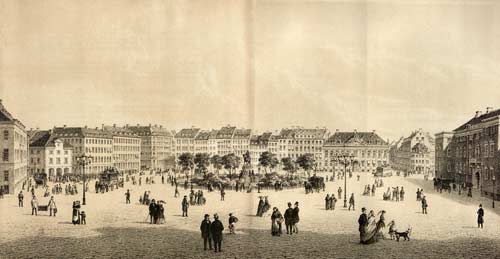
Illustration on the back double end‑paper:
Kongens Nytorv, Copenhagen |
|

